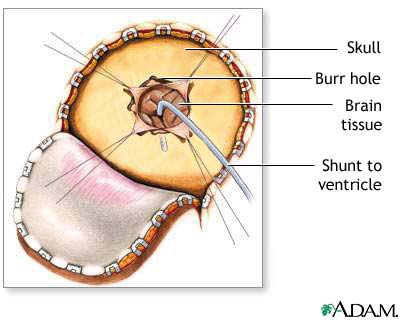


 |  |  |
| | ||
Craniotomy for cerebral shunt

During a cerebral shunt procedure a flap is cut in the scalp and a small hole is drilled in the skull. A small catheter is passed into a ventricle of the brain. A pump (valve which controls flow of fluid) is attached to the catheter to keep the fluid away from the brain. The accumulation of excess fluid around the brain can cause an increase in intracranial pressure. The excess pressure can cause a decrease in blood flow to the brain leading to brain damage.
Update Date: 5/3/2007 Updated by: Robert A. Cowles, M.D., Assistant Professor of Surgery, Columbia University College of Physicians and Surgeons, New York, NY. Review provided by VeriMed Healthcare Network.
